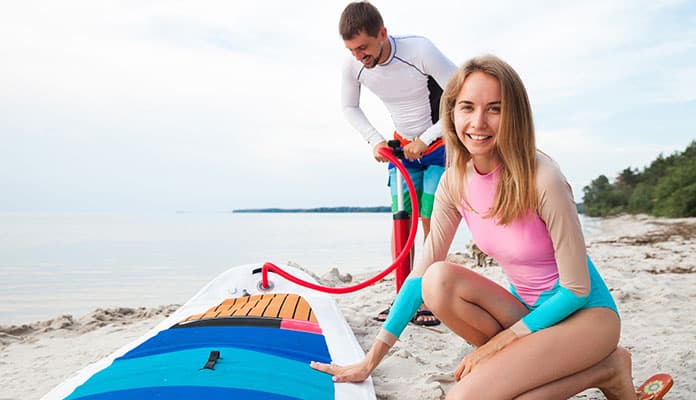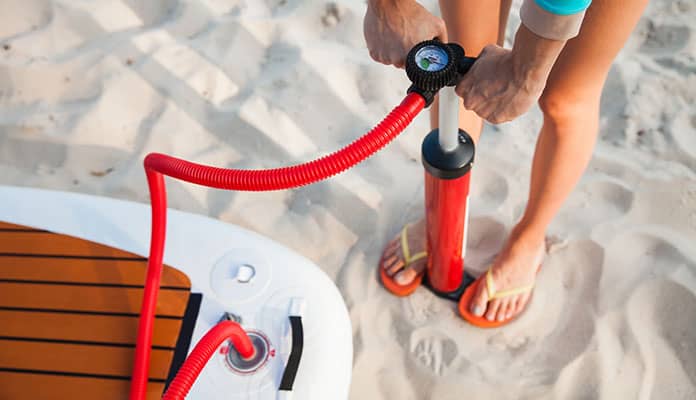
Inflating a paddleboard is an easy task if you know what you’re doing. It is important to learn how to inflate your stand up paddleboard (SUP) before heading to the beach. It will not only save you time and get you in the water quickly, but you’ll start your boarding with confidence. Many different brands make inflatable stand up paddleboards, but they are very similar in the way they are inflated. There are a few things you should consider before inflating your board, as the common issues people run into when inflating their SUP.
Under-inflated Board
People usually underinflate their boards. For whatever reason, they don’t get their boards to pressure up to 15 pounds per square inch (PSI). This can cause your board to not function properly and even bend in ways it shouldn’t.
Pro Tip: An easy way to tell if your board is properly inflated without a pressure gauge is to stand on it in the water. If it feels soft, as in your feet sink into the board, chances are it is not inflated to where it should be.
Every inflatable board should come with a pump that has been specially designed for that board. This pump should also have a pressure indicator which will indicate when your board has been fully inflated.
Keep in mind that if you inflated your board in the morning and it sits in the sun all day it can change pressure. The heat from the sun and sand can cause the pressure to increase. But when you bring it onto the water, which is cooler, the pressure can decrease making it seem underinflated. If this happens you may need to give it a few more pumps of air to keep it at the proper PSI.
Electric Pumps
We hate hearing stories about people filling their boards with too much air. The most common way this happens is with an electric pump. If you only have an electric pump we strongly recommend making sure the PSI gauge works properly.
With that being said, you can still use your electric pump, just be careful. What we do is fill our board to around 11 PSI with an electric pump and then switch to the hand pump. We know the last few PSI are the hardest to get with a hand pump, but this way ensures that we have full control.
You might also like: All Paddle Board Accessories
Pro Tip: If you have to plug your electric pump into your car to fill your board, ensure the car is running. These pumps have been known to kill car batteries if the car is off.
Using Your Electric Pump
- Unroll your board and grab your pump. Make sure your pump has a gauge on it, if it doesn’t we don’t recommend using it.
- Find your inflation cap on your board and make sure it is in the fill orientation. Most boards have an arrow on the board and a cap that connects to let you know it is the right spot.
- Attach the pump to your board. Make sure you have the nozzle connected to the inflation side. Most pumps have two connection points, one for inflation and one for deflation.
- Turn on your pump. Do not walk away from it! This could be disastrous. Electric pumps do not stop when they get to a certain PSI. Once you get past 10 PSI you will hear your pump engine start to work hard.
- Once it’s around 12 PSI you can take it out and finish it up with a hand pump. If you don’t have one, you can pump it to 15 PSI, just be careful not to exceed that number.
- Disconnect the pump and replace the cap and you are ready to go!
Using Your Hand Pump to Fill Your SUP

This is very similar to using an electric pump.
- Unroll your board.
- Hook up your pump to your board.
- Pump air into your board. It will be easy at first but gets harder as you reach 15 PSI.
Globo Surf Overview
Inflating your SUP shouldn’t take more than 10 minutes. It isn’t the hardest task to learn but understanding how it works will help you get into the water quickly. We suggest practicing once at home before getting to the water. This will help you understand the process and how your board looks and feels before getting to the water.
More Paddle Board Accessories Guides
- Paddle Board Fin Replacement And Buying Guide
- How to Store a Stand Up Paddle Board
- How to Store Your Stand Up Paddle Board
- Paddle Board Fin Replacement And Buying Guide
Paddle Boards Accessories:

